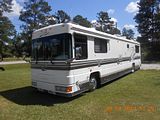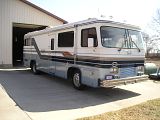Go to...  | Start A New Topic  | Search  | Notify  | Tools  | Reply To This Topic  |  |
 |
I received the following from a drag racer friend of mine. I can't verify any of the numbers but I thought some of the more mechanically minded members might get a kick out of the comparisons here. Nick 'DEFINITION OF ACCELERATION' One top fuel dragster 500 cubic inch Hemi engine makes more horsepower than the first 4 rows of stock cars at the Daytona 500. It takes just 15/100ths of a second for all 6,000+ horsepower of an NHRA Top Fuel dragster engine to reach the rear wheels. Under full throttle, a dragster engine consumes 1-1/2 gallons of nitro methane per second; a fully loaded 747 consumes jet fuel at the same rate with 25% less energy being produced. A stock Dodge Hemi V8 engine cannot produce enough power to drive the dragster's supercharger. With 3,000 CFM of air being rammed in by the supercharger on overdrive, the fuel mixture is compressed into a near-solid form before ignition. Cylinders run on the verge of hydraulic lock at full throttle. At the stoichiometric (stoichiometry: methodology and technology by which quantities of reactants and products in chemical reactions are determined) 1.7:1 air/fuel mixture of nitro methane, the flame front temperature measures 7,050 deg F. Nitro methane burns yellow. The spectacular white flame seen above the stacks at night is raw burning hydrogen, dissociated from atmospheric water vapor by the searing exhaust gases. Dual magnetos supply 44 amps to each spark plug. This is the output of an arc welder in each cylinder. Spark plug electrodes are totally consumed during a pass. After halfway, the engine is dieseling from compression, plus the glow of exhaust valves at 1,400 deg F. The engine can only be shut down by cutting the fuel flow. If spark momentarily fails early in the run, unburned nitro builds up in the affected cylinders and then explodes with sufficient force to blow cylinder heads off the block in pieces or split the block in half. In order to exceed 300 mph in 4. 5 seconds, dragsters must accelerate an average of over 4G's. In order to reach 200 mph (well before half-track), the launch acceleration approaches 8G's. Dragsters reach over 300 miles per hour before you have completed reading this sentence. Top fuel engines turn approximately 540 revolutions from light to light! Including the burnout, the engine must only survive 900 revolutions under load. The redline is actually quite high at 9,500 rpm. Assuming all the equipment is paid off, the crew worked for free, and for once NOTHING B LOWS UP, each run costs an estimate $1,000.00 per second. The current top fuel dragster elapsed time record is 4.428 seconds for the quarter mile (11/12/06, Tony Schumacher, at Pomona , CA ). The top speed record is 336.15 mph as measured over the last 66' of the run (05/25/05 Tony Schumacher, at Hebron , OH ). Putting all of this into perspective: You are driving the average $140,000 Lingenfelter 'twin-turbo' powered Corvette Z06. Over a mile up the road, a top fuel dragster is staged and ready to launch down a quarter mile strip as you pass. You have the advantage of a flying start. You run the 'Vette hard up through the gears and blast across the starting line and pass the dragster at an honest 200 mph. The 'tree' goes green for both of you at that moment. The dragster launches and starts after you. You keep your foot down hard, but you hear an incredibly brutal whine that sears your eardrums and within 3 seconds, the dragster catches and passes you. He beats you to the finish line, a quarter mile away from where you just passed him. Think about it, from a standing start, the dragster had spotted you 200 mph and not only caught, but nearly blasted you off the road when he passed you within a mere 1,320 foot long race course. ... and that my friend, is ACCELERATION! | ||
|
 10/10 10/10 |
Well done Nick. I don't follow racing but the numbers and the comparisons you provided are quite interesting. I'm sure the guys at coffee break will enjoy them too as some of them are big time NASCAR fans. Ron 1993, 34', Regency, Widebody 300 HP Cummins 6 spd Allison, Spartan Chassis | |||
|
| First Month Member |
OK..........I am terminating contributions to my Lingenfelter fund. Gonna put it in my Barth instead. Thanks for busting my bubble. . 84 30T PeeThirty-Something, 502 powered | |||
|
FKA: noble97monarch 3/12 3/12 |
One of the fun perks of my job is that once a year I get to hang out with Tony Schumacher (The Sarge) and his crew chief at the Army's annual event in DC (he drives the Army TF Dragster). Being a gear-head from way back, I've quizzed them up and down about the top fuel cars and techniques and I recall these amazing facts in addition to your awesome list. Q: I asked how many runs they get out of a set of slicks. A: one run if it's a good hook up. Reason: the wheels spin 3 times more revolutions than if you simply rolled the car down the track. They are essentially "laying down" all the rubber the tire has to give in a perfect hook up! Q: I asked how they can do a complete rebuild of an engine outdoors in a dusty/dirty environment? When ever I've done engine work it was critical to keep every piece of dust/dirt from contaminating the rebuild. A: You want to get 100,000 miles out of your engine, we need to get 1/4 mile! Furthermore, when a top fuel engine is at full throttle, a small bird could fly through it without hitting anything (metaphorically as the bird would be cooked naturally). Q: How do you steer the car at 300 MPH with skinny little tires that are hardly touching the ground? A: Those tires are used more like rudders in the air. I also asked about the transmission (of sorts) in the car. Essentially there are mechanical weights that throw clutches to the next gear. It is interesting that in this day and age that this is still a simple mechanical device. One final tidbit for the next time you watch a drag race, there are two fuel pumps - one for the burnout and a second one is engaged for the run. You can actually hear the second one kick in on TV when watching a race. As there is no coolant in these "motors", staging and launch must happen relatively quickly or disaster can occur. Anyway, fun stuff! Corey  Formerly: 1997 Barth Monarch Now: 2000 BlueBird Wanderlodge 43' LXi Millennium Edition DD Series 60 500HP 3 stage Jake, Overbuilt bike lift with R1200GS BMW, followed by 2011 Jeep Wrangler Unlimited, “I haven’t been everywhere, but it’s on my list.” | |||
|
"Host" of Barthmobile.com 1/19 1/19 |
From what I understand, it's just filled with sand or cement.
| |||||||||||||||
| ||||||||||||||||
| First Month Member |
I poured a concrete/ceramic mix in the lower water jacket of a boat engine to reinforce the lower block due to extreme overbore. I think I got it from Traco. . 84 30T PeeThirty-Something, 502 powered | |||
|
| Powered by Social Strata |
| Please Wait. Your request is being processed... |
|
This website is dedicated to the Barth Custom Coach, their owners and those who admire this American made, quality crafted, motor coach.
We are committed to the history, preservation and restoration of the Barth Custom Coach.
We are committed to the history, preservation and restoration of the Barth Custom Coach.

